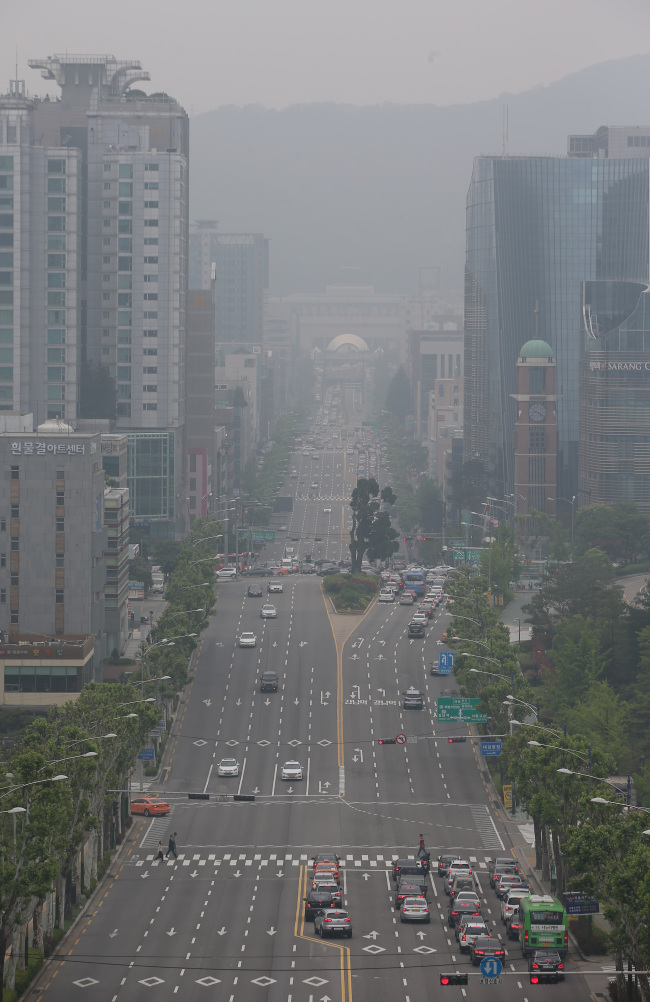Breathing in South Korea has become more risky. There have been a slew of reports from overseas that warned of worsening air pollution in Korea, with the latest being Yale University’s study released last Friday. It found that Korea ranked 173rd out of 180 countries in terms of air quality.
One of the main culprits for the worsening air quality is particulate matter, otherwise known as fine dust. The small particles -- 2.5 micrometers or less in diameter -- can penetrate deep into the respiratory organs and blood vessel, causing serious illness such as lung cancer, stroke, heart diseases, and both chronic and acute respiratory diseases.
But the origin of the toxic matter and the measures to prevent them remain debatable, leaving the general public mystified about how they should go about their daily lives. Here are some clarifications on some of the misperceptions toward fine dust.
 |
The sky in Seoul city is covered with fine dust. Yonhap |
Most fine dust in South Korea comes from China
False. Certainly, yellow dust is mostly blown from the desert of Mongolia and Northern China, bringing with it some toxic particles picked up along the way. However, according to Greenpeace in 2015, 50 to 70 percent of the harmful dust came from South Korea’s coal power plants.
A government study also supports the claim. The Comprehensive Plan for Fine Dust, an interagency study published in December 2013, found that only some 30 to 50 percent of the toxic material came from overseas.
Grilling mackerel indoors is worse than walking around in “very poor” air quality
True. A 2016 report from the Environment Ministry said that grilling mackerel without proper ventilation can produce 2,290 micrograms of particulate matter per cubic meter, about 20 times greater in density than the level considered to be “very harmful,” which is 101 microgram per cubic meters.
The World Health Organization said in its 2014 report that in addition to outdoor air pollution, indoor smoke is a serious health risk for some 3 billion people who cook and heat their homes with biomass fuels and coal.
Depending on the cooking method, the level of the toxic material varies. Grilling is known to produce almost eight times more ultrafine dust then boiling, and more than three times the amount produced by frying. Health officials recommend that people keep windows open when grilling fish or other food.
Diesel cars are more harmful than gasoline cars True. Diesel cars produce about 20 times more particulate matter and nitrogen oxide than cars powered by gasoline, according to the Environment Ministry, which has imposed a strict limit on the amount of gas being produced by diesel cars.
However, some local media outlets have claimed that diesel and gasoline cars emit pretty much the same amount of toxic matter into the air. Citing a 2009 experiment conducted by the Korea Institute of Energy Research, they criticized the government for singling out diesel cars as the main cause of pollutants.
But a KIE official has refuted the argument, saying that the result does not include the amount of nitrogen oxide that contributes to the creation of toxic particles.
Working out is still good even in bad air as benefits outweigh risks
False. Working out requires more use of the mouth for breathing than the nose, hence increasing the amount of fine dust that enters the body.
According to a 2015 study from Intermountain Healthcare, people with heart disease face an increased risk of a serious heart attack during days with poor air quality, which refers to days with above 25 micrograms of fine particulate matter per cubic meter of air
Wearing masks can protect one from all harmful dust
False. Some ultra-small harmful particles can still penetrate through average dust masks. Depending on the level of protection, masks designed specifically for fine dust are classified into three types and assigned different “KF” numbers – 80, 94 and 99. The number refers to the thickness of the masks. These masks are known to filter out more than 80 percent of the toxic dust.
But young kids, pregnant women and asthma patients should be careful not to choose masks that have higher protection levels. If the mask is too thick, they could have more trouble breathing. Authorities say that the KF 80 mask is sufficient enough for those who have weaker respiratory systems.
If the sky is blue, we are safe from air pollution
False. Weather experts say that the blueness of the sky is determined by the size of the particulate matter. If the particles are less than 2.5 micrometers in diameter, they prevent sunlight from reaching the ground, making the sky become unclear.
So we can have blue skies even when the air is peppered with dust – as long as they are not small enough to be dispersed by sunlight. For instance, the skies were clear during the final week of last April, but the authorities had issued warnings for the harmful dust, which mostly consisted of larger particles.
By Yeo Jun-suk (
jasonyeo@heraldcorp.com)








